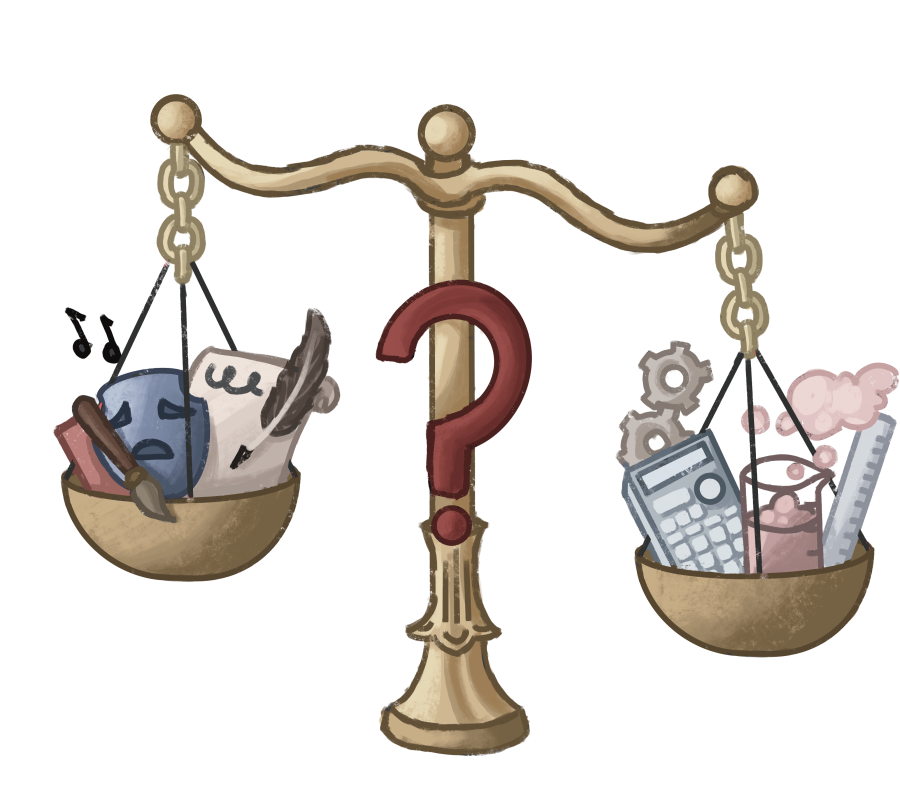More Than Meets the Eye: The Value of Humanities in a STEM World
In the pursuit for success, the equation seems straightforward: STEM education equals practical careers, which equals financial prosperity.
In our capitalistic system, this equation has become ingrained in the modern American workforce, resulting in an exponential increase in STEM majors. Conversely, according to the Wall Street Journal in 2023, humanities majors have plummeted by over 30% in the past decade, reaching a mere 4% in 2020. This is largely due to the perception that studying STEM secures a path to success, given the rising demand for STEM professions in our technological revolution. In this context, it is crucial to examine the question: What is the value in studying the humanities, subjects like philosophy, literature, and history?
In an age where STEM education often takes center stage, it’s essential to recognize the enduring significance of the humanities, as it represents the essence of human society, delving into areas beyond STEM’s grasp. STEM and humanities involve largely different ways of thinking. According to the University of Nebraska-Lincoln’s paper in 2020, STEM-minded thinkers tend to foster “critical thinking, logic, and practicality,” while those in humanities “reinsert…human need, desire, creativity, aesthetics, and vulnerability” into society. STEM presents cold, hard facts and truths. Humanities, on the other hand, questions the intangible. Whereas science addresses the physical aspects of what we are, humanities prompt us to explore the emotional and philosophical dimensions of humanity that involve more questions than answers.
While society has emphasized the practicality of STEM, it is important to re
member that both fields play vital roles in our education and the world at large. STEM equips individuals with the problem-solving skills needed to improve the world. At the same time, humanities are the colors we use to paint a view of our shared human experience, providing crucial insight into aspects of the community that science cannot always offer. Thus, a strong foundation in the humanities must be incorporated, now more than ever, alongside our increasing focus on STEM.
The Student Perspective:
It is disheartening to see how many high school students dismiss the humanities for STEM when making their academic plans. Recently, Dougherty Valley High School in California conducted an online poll taken by 600 high school students showing that 71.3% of students wanted to pursue a pathway in STEM while only 21.7% wanted to pursue a humanities education. The popular inclination towards STEM fields is not only influenced by societal pressures, but also the notion that pursuing subjects such as science, technology, engineering, or math offer more direct pathways to successful and financially rewarding careers in fields such as medicine and engineering.
Many argue that since STEM is a much more practical path, it deserves more funding and focus in schools than the humanities. This perspective derives from the assumption that the humanities lack direct real-world relevance. However, this notion does not acknowledge the pivotal role the humanities play in nurturing essential life skills, such as communication and ethical decision-making. While STEM subjects may build strong foundations in quantitative analysis, studying the humanities fosters strong critical thinking and communication skills. Writing an essay, giving a presentation, or debating a social issue, is a skill that humanities demands, necessary for success in higher education and beyond.
Studies by Shemmassian Academic Consulting from 2022-2023 show that those who applied to medical school with a humanities major had a 51% acceptance rate, which is higher than any of the other majors including Biological Sciences (41%), Math & Statistics (45%), Physical Sciences (46%), and more. Humanities skills are invaluable in all disciplines and can even be applied to STEM professions.
These intersections between STEM and the humanities occur at Greeley. Junior Adi Gunnar shares that while he and his classmates often view STEM and the humanities as different subjects, there have been instances where the fields intersected. For instance, Gunnar describes how “researching information for a global history class based on past dictators and empires,” drew on the same skills when learning experiences where “students had to gather information about different sciences.”
An Interdisciplinary Approach:
An interdisciplinary approach that seamlessly integrates STEM and humanities education offers unique opportunities. By exploring diverse perspectives in the humanities, students are encouraged to think critically and creatively, allowing them to develop groundbreaking solutions to real-world challenges within areas of STEM. This merge of ideas leads to the creation of technologies and advancements that consider human needs within technological contexts, ultimately enhancing their relevance and impact. For instance, though artificial intelligence is rapidly increasing in popularity, its development cannot continue without discussions regarding ethics, and how AI can best uphold our society’s morals, values, and laws.
Real-world examples from the U.S. Department of Education show how “collaborations between STEM and humanities were crucial to some of the largest breakthroughs.” One such instance is the area of human-robot interaction, where engineers and computer scientists partner with psychologists and sociologists. This collaboration has improved robots to better understand and engage with humans, revolutionizing industries from healthcare to customer service. Another collaboration highlighted by the department can be found between archaeology and technology, where archaeologists collaborate with experts in advanced technologies to unearth ancient civilizations and historical sites. These examples underscore the significance of interdisciplinary teamwork, which contribute to the compendium of human knowledge.
Global 9 teacher Mrs. Emily Frawley affirms the necessary partnership between STEM and humanities in real-world applications. Mrs. Frawley shares, “So much of history and other social sciences revolve heavily on scientific concepts.” Having a background in teaching both the sciences and global history for several years, she further concludes that her strong background in science “has definitely helped inform the way I approach so many of these topics in my [history] classes.”
In today’s dynamic world, the relationship between STEM and humanities is a testament to the power of interdisciplinary collaboration. Indeed, the real-world examples of intersection between these two areas can result in extraordinary knowledge and creativity. In essence, the bridge between STEM and humanities is where innovation, empathy, and progress flourish, creating a brighter and more enlightened society.





